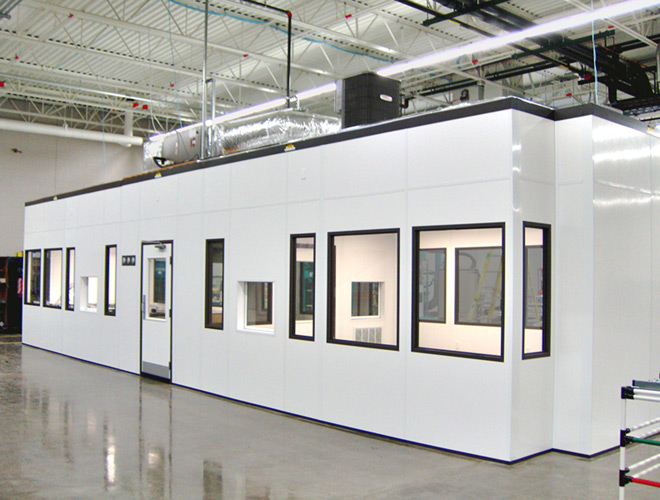When designing a new cleanroom, the first and most critical decision is whether it will be traditional or modular construction. Each option has benefits and limitations, and it can take time to determine which is best for your application.
We can help. Here are the major differences between modular cleanrooms vs. traditional construction cleanrooms.
What Is a Traditional Cleanroom?
A traditional cleanroom is a highly controlled environment designed to minimize the presence of airborne particles, contaminants, and pollutants. These permanent installations are typically constructed with studs and drywall and integrated into the building’s architecture. They utilize advanced HVAC systems with HEPA or ULPA filters to maintain strict control over environmental factors such as temperature, humidity, and pressure.
What Is a Modular Cleanroom?
A modular cleanroom is a flexible and scalable controlled environment that offers the same level of contamination control as traditional cleanrooms, plus the benefits of adaptability and cost-efficiency. Constructed using prefabricated panels and components, modular cleanrooms can be quickly assembled, disassembled, and modified to meet changing production needs or accommodate new processes.
Traditional Cleanroom Construction vs. Modular Cleanrooms
When deciding between traditional and modular cleanrooms, consider various factors such as flexibility, cost, installation, maintenance, and customization to determine which option best suits your specific needs.
Flexibility
For applications requiring flexibility, modular construction is your best bet. Traditional construction cleanrooms can’t be packed up and moved to another location. Nor is it as easy to expand as modular construction, where adjustments are minor, such as detaching a few panels and adding more to them. Instead, you have to renovate and knock out walls.
Depending on your cleanroom use and classification, you could build a super-flexible Softwall cleanroom with impermanent curtain-like walls. You could also opt for a Rigidwall or Hardwall cleanroom with thicker, more substantial wall panels. All of these options are still flexible, modular cleanrooms.
Cost
The cost of every cleanroom will vary depending on the size, application, special features, and construction type. Generally, modular cleanrooms are more expensive than traditionally built cleanrooms.
In addition to upfront costs, depreciation is something to consider when building a cleanroom. Modular cleanrooms qualify for accelerated depreciation, typically over seven years or less, whereas traditionally constructed rooms follow a 39-year depreciation schedule. This difference in depreciation timelines can impact financial planning and tax benefits for businesses.
Installation
While traditional cleanrooms can take months to build, modular construction is much simpler as the components are already manufactured. Instead of building walls from raw materials, with modular cleanrooms, the components simply need to be assembled to your specifications. Modular installation can take as little as a few days or weeks to complete, which is crucial to getting your operations up and running as soon as possible.
Additionally, while you’ll always need to hire pros for traditional construction, a modular cleanroom (typically smaller and less complicated cleanrooms) can often be assembled in-plant by your staff, with the instructions provided by the manufacturer. The manufacturer may even offer installation services at an additional cost or as part of a modular cleanroom design package.
Maintenance
Traditional cleanroom maintenance can be quite demanding due to its permanent nature and the need for continuous compliance with stringent cleanliness standards. Regular and thorough cleaning, frequent filter replacements, and ongoing monitoring of environmental parameters are necessary to maintain the integrity of a traditional cleanroom.
On the other hand, modular cleanrooms typically require less intensive maintenance. Their modular nature allows for easier access to components that need cleaning or replacement. Additionally, if a section of the cleanroom needs to be decontaminated or upgraded, it can be done without affecting the entire facility, reducing downtime and maintenance costs.
Customization
Due to their permanent construction and integration into the building’s architecture, traditional cleanrooms offer fewer customization options. Changes or upgrades often require significant construction work, which can be time-consuming and expensive.
Modular cleanrooms offer a higher degree of customization with minimal disruption. They can be tailored to specific needs, whether adjusting the layout, adding new features, or upgrading to meet higher cleanroom classifications. The modular approach allows for quick modifications and scalability, enabling businesses to adapt their cleanroom environment to evolving requirements without significant overhauls.
Why Choose Angstrom Technology for Your Modular Cleanroom Needs?
If you’re designing a cleanroom, contact Angstrom Technology to discover how our state-of-the-art modular cleanroom designs can meet your unique requirements. Our expert team is dedicated to providing flexible, cost-effective, and customizable solutions that ensure your cleanroom operates at peak efficiency.
Whether you need a quick installation, easy maintenance, or the ability to scale and adapt your cleanroom environment, Angstrom Technology has the expertise and innovative solutions to make it happen. Contact us today to learn how we can help you achieve a cleanroom that not only meets but exceeds your expectations.


